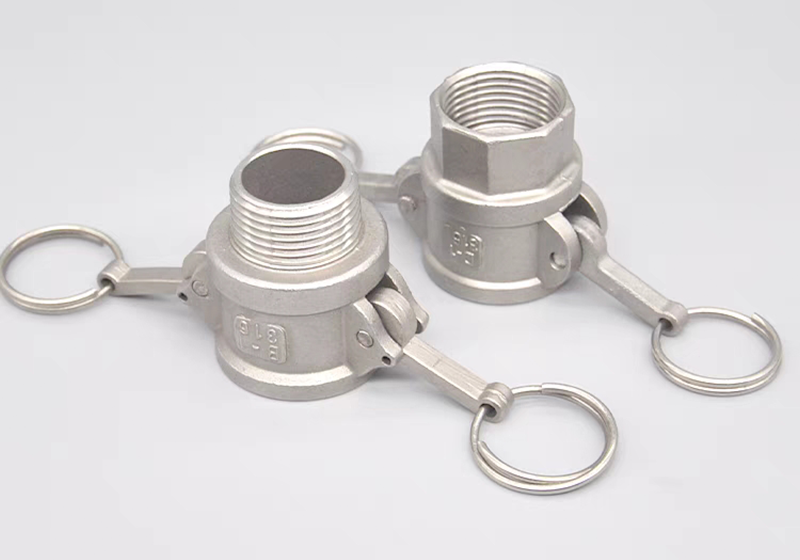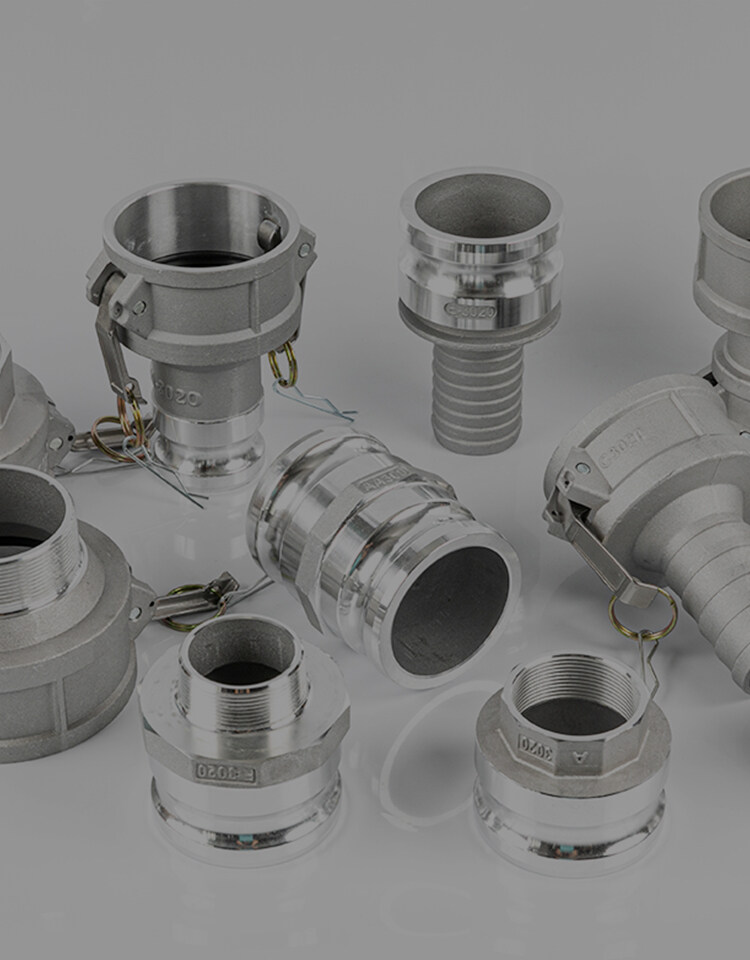E-Mail-Formatfehler
emailCannotEmpty
emailDoesExist
pwdLetterLimtTip
inconsistentPwd
pwdLetterLimtTip
inconsistentPwd

Nachricht
Hier können Sie einen Text beschreiben, den Sie ausdrücken möchten

Unlocking the Potential of Cam Lock Male Connectors in Fluid Transfer Systems
In the intricate dance of industrial fluid management, every component plays a pivotal role in maintaining the rhythm of productivity and safety. Among these, cam lock male connectors stand out as the maestros of quick and secure hose connections. These ingenious devices, also known as cam and lock fittings, have carved a niche for themselves in a multitude of industries where fluid transfer is a daily operation. With their unparalleled ability to connect and disconnect with a simple snap, they have streamlined processes and enhanced efficiency across the board.
In this comprehensive exploration, we will delve into the world of cam lock male connectors, unraveling their design, functionality, and the myriad of applications they adeptly serve. From the verdant expanses of agriculture to the meticulously controlled environments of chemical processing plants, the connectors have proven to be an indispensable ally. Join us as we unlock the potential of these fittings and discover how they can transform your fluid handling systems from the ordinary to the extraordinary.
The Basics of Cam Lock Male Connectors
At its core, a cam lock male connector is a marvel of simplicity and efficiency. Designed to provide a swift and secure means of connecting hoses and pipes, these connectors feature a male groove adapter that seamlessly fits into a female cam coupler. The magic happens when the cam levers—situated on the female coupler—are flipped down, exerting pressure over the male adapter and creating a tight seal that can withstand significant pressure without the risk of disconnection or leakage.
The beauty of the cam lock system lies in its ease of operation. Unlike threaded or flanged connections, which require tools and time to assemble, the cam fitting can be engaged and disengaged by hand in mere seconds. This feature is invaluable in situations where time is critical, such as in emergency water supply scenarios or when transferring volatile chemicals that demand rapid handling.
Advantages of Using Cam Lock Male Connectors
The adoption brings with it a host of advantages that can significantly boost the efficiency and safety of fluid transfer operations. Here are some of the key benefits that make these connectors a preferred choice:
Speed of Connection: Time is a precious commodity in industrial operations, and cam lock male connectors are the epitome of time-saving technology. Their quick connect and disconnect capability allows for fast setup and breakdown of transfer systems, minimizing downtime and maximizing productivity.
Ease of Use: The intuitive design of cam and lock fittings means that they can be operated with minimal training. The straightforward action of opening and closing the cam arms allows even novice users to make secure connections, reducing the likelihood of errors and accidents.
Versatility: They are not one-trick ponies; they come in a variety of sizes and materials, each tailored to specific types of fluids and operating conditions. Whether you’re transferring water, oil, or aggressive chemicals, there’s a cam fitting designed to handle it.
Durability: Constructed from robust materials, they are built to last. They can withstand repeated use and exposure to harsh substances without significant wear, ensuring a long service life and reducing the need for frequent replacements.
Leak Prevention: The secure locking mechanism of cam and lock fittings provides a leak-proof seal that stands up to high pressures. This is crucial for maintaining the integrity of fluid transfer systems and protecting the environment from potential spills.
Types of Cam Lock Male Connectors
Cam lock male connectors come in a variety of types, each designed to meet specific requirements and applications. Understanding the differences between these types is crucial for selecting the right connector for your system.
Type A (Male Adapter x Female Thread): This connector features a male grooved adapter on one end and a female BSP or NPT thread on the other. It is commonly used to connect flexible hoses to female-threaded outlets, such as water pumps or tanks.
Type F (Male Adapter x Male Thread): Type F connectors have a male grooved adapter and a male BSP or NPT thread. They are ideal for connecting hoses to female-threaded inlets or equipment, providing a secure connection that can withstand high-pressure applications.
Each type of cam lock male connector is designed for ease of use and reliability. The choice between them depends on the specific needs of your fluid transfer system, such as the type of hose or pipe you are using and the required connection style.
Materials and Construction of Cam Lock Male Connectors
They are made from a range of materials, each offering distinct properties and benefits. The most common materials include:
Aluminum: Lightweight and corrosion-resistant, aluminum cam lock connectors are suitable for a wide range of applications, especially where weight is a concern.
Stainless Steel: Known for its strength and resistance to corrosion, stainless steel is ideal for applications involving harsh chemicals or extreme temperatures.
Polypropylene: This plastic material offers excellent chemical resistance and is often used in agricultural and chemical processing applications.
Brass: Brass cam lock connectors are known for their durability and are commonly used in applications where they are exposed to water, as they resist corrosion from water exposure.
Applications of Cam Lock Male Connectors
The versatility makes them suitable for a wide range of applications across various industries:
Agriculture: Used in irrigation systems, cam lock connectors, including the cam hose variety, allow for quick changes and secure connections, which are essential for efficient water management.
Chemical Processing: In an industry where safety is paramount, cam lock connectors, such as the cam groove coupling, provide a reliable means of transferring corrosive substances without leaks.
Oil and Gas: The robust construction of cam lock connectors ensures they can handle the high pressures and volatile substances commonly found in the oil and gas industry.
Pharmaceuticals: Maintaining purity is critical in pharmaceuticals, and cam lock connectors offer a clean and secure way to transfer sensitive liquids.
Food and Beverage: The non-toxic nature of certain cam lock connector materials, like polypropylene, makes them suitable for use in food and beverage applications where contamination must be avoided.
Installation Tips for Cam Lock Male Connectors
Proper installation is essential for ensuring a secure and leak-free connection. Here are some tips to help you install male connectors correctly:
Inspection: Before installation, inspect the connector for any signs of damage or debris that could compromise the seal.
Gasket Check: Ensure the gasket is in place and in good condition. A properly seated gasket is crucial for preventing leaks.
Alignment: Align the male adapter with the female coupler carefully before connecting them.
Engagement: Once aligned, insert the male adapter into the female coupler and press down the cam arms to lock the connector in place.
Test: After installation, test the connection with a low-pressure fluid to ensure there are no leaks.
Maintenance and Care for Cam Lock Male Connectors
To extend the life of your cam lock male connectors and maintain their performance, regular maintenance is necessary. This includes:
Regular Cleaning: Keep the connectors clean, especially the sealing surfaces, to prevent contamination and ensure a tight seal.
Inspection: Regularly inspect the connectors for signs of wear or damage, such as cracks or erosion.
Lubrication: Apply suitable lubricants to the moving parts of the connector, if necessary, to ensure smooth operation.
Replacement: Replace gaskets or other components if they show signs of deterioration to maintain the integrity of the connection.
Safety Considerations When Using Cam Lock Male Connectors
Safety should always be a top priority when using the connectors, especially when handling hazardous materials. Here are some safety considerations to keep in mind:
Proper Connection: Always ensure that the connectors are properly engaged and locked before starting fluid transfer.
Pressure Ratings: Be aware of the pressure ratings of your connectors and do not exceed them to avoid connector failure.
PPE: Wear appropriate personal protective equipment, such as gloves and goggles, when handling hazardous fluids.
Training: Ensure that all personnel are trained in the correct use of cam lock fittings and are aware of the safety procedures.
Conclusion: The Role of Cam Lock Male Connectors in Efficient Fluid Handling
Cam lock male connectors are a vital component in modern fluid handling systems, offering speed, ease of use, and reliability. Whether you’re working in agriculture, chemical processing, or any other industry that involves fluid transfer, these connectors can enhance the efficiency and safety of your operations. By understanding the types, materials, applications, and proper usage, you can unlock their full potential and keep your systems running smoothly.

